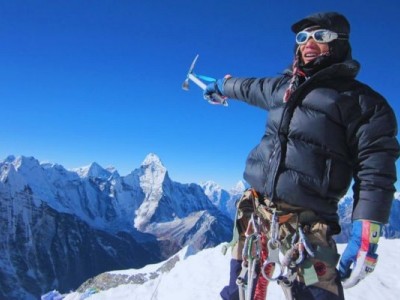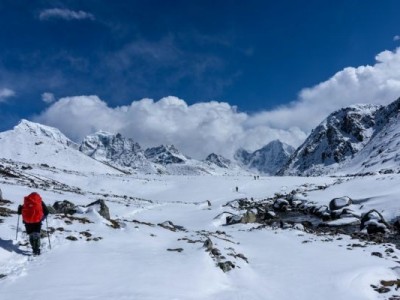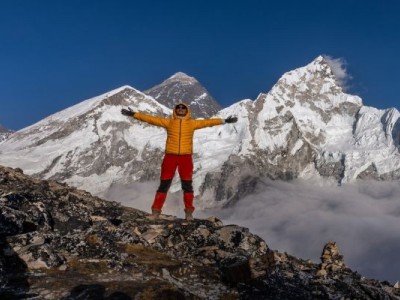Why Trek Pikey Peak in Winter?
The Pikey peak trek in Winter is an excellent choice for trekkers seeking Nepal's Himalayas. As one of the Best winter treks in Everest region. While most popular trails in the Everest region get crowded during peak seasons, this low-altitude winter trek offers a peaceful experience through untouched snow-covered landscapes and serene Sherpa villages. The trail is relatively offbeat, making it perfect for those who seek solitude, cultural connection, and raw natural beauty.
One of the biggest highlights is the panoramic view from the summit of Pikey Peak (4,065 meters). On a clear winter morning, you can enjoy one of the best sunrise views of Mt. Everest, along with other peaks from the Mahalangur Himalayan range. The visibility in winter is often excellent, offering crisp and uninterrupted vistas that are hard to find during other seasons.
The trek usually takes about 6 to 8 days, depending on your pace and route. It’s moderately challenging and suitable for both beginners and experienced trekkers. Winter adds a touch of adventure with snowy trails and colder temperatures, but the trail remains safe with proper gear and guidance. Plus, the warmth of Sherpa hospitality along the way makes this Himalayan journey even more memorable.

Pikey Peak Trek in December
While the trail can be explored year-round, the best time to trek Pikey Peak—especially for clear views and fewer crowds—is during the winter months from December to February.
The Pikey peak trek in December is a magical experience. This Winter season pikey peak trek combines early winter sets in, the trails begin to receive fresh snow, covering the landscapes with a soft white blanket. The air is cold but clean, and the skies are often crystal clear, offering some of the best mountain views of the year. From the summit of Pikey Peak, you can see a panoramic sweep of the Mahalangur Himalayan range, including Mt. Everest glowing at sunrise.
December is also a special time in the mountain villages. While it’s quieter than the autumn trekking season, the local Sherpa communities remain warm and welcoming. Many villages prepare for winter festivals and traditional gatherings, giving you a chance to witness local customs and experience the cultural richness of the region. Monasteries may hold prayer ceremonies, and the smell of wood fires fills the cold air.
Although temperatures drop significantly at night, the days are usually sunny and comfortable for walking. With the right winter gear and the support of expert guides from Himalayan Ecological Trekking, December becomes a perfect time for adventure seekers to enjoy an offbeat and peaceful Himalayan trek. It's a satisfying combination of visual beauty and cultural connections.
Pikey Peak Trek in January
The Pikey peak trek in January has the deepest snow. Ideal for Pikey peak winter trekking enthusiasts, quietest routes, and some of Nepal's most stunning scenery. This is the coldest month of the year, but also one of the most peaceful times to experience the Himalayas in their purest form. The entire route feels silent and still, with soft snow covering forests, rooftops, and meadows, creating a postcard-like atmosphere throughout the journey.
For those who enjoy solitude and raw nature, January is ideal. The trails are less busy, giving you more time to reflect and truly connect with the environment. The views remain stunning—on clear mornings, you can see a wide stretch of the Mahalangur Himalayan range, including Mt. Everest, glowing under the winter sun. The snow-covered peaks and blue skies create a surreal contrast that feels almost dreamlike.
While January trekking requires preparation for cold conditions, it is safe and manageable with proper clothing, footwear, and the guidance of experienced teams like Himalayan Ecological Trekking. Heated lodges and warm Sherpa meals provide comfort at the end of each day. If you're looking for a unique winter trek filled with silence, snow, and spectacular beauty, January is the perfect time to explore Pikey Peak.
Pikey Peak Trek in February
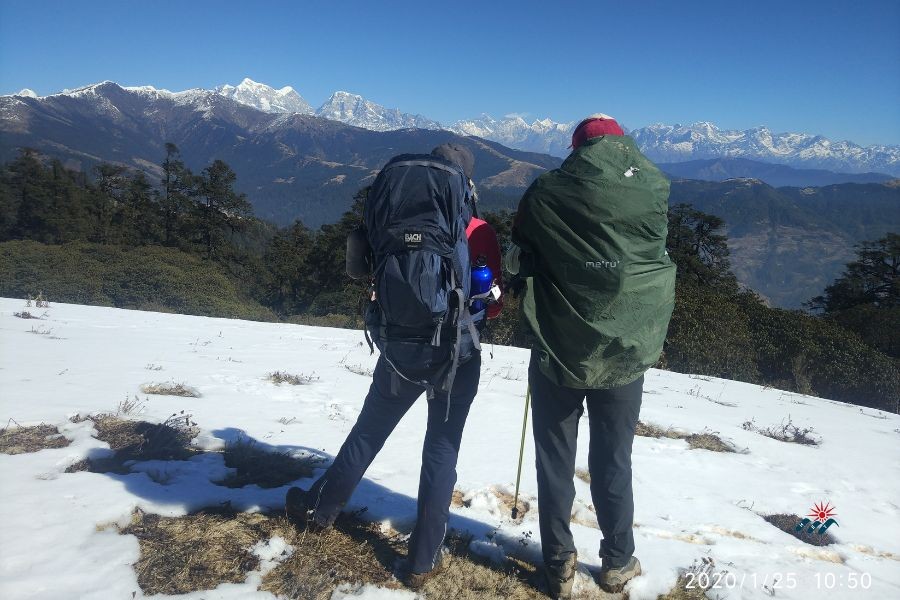
The Pikey peak trek in February marks the gentle transition. This pikey peak trek in Winter season blends from deep winter to early spring in Nepal’s lower Everest region. The days start getting slightly warmer, making the trek more comfortable for those who prefer milder cold. Snow still lingers on the higher trails and ridges, but lower elevations begin to show early signs of color, especially the first hints of blooming rhododendron, Nepal’s national flower.
February is ideal for trekkers who want the best of both worlds: the snowy charm of winter and the refreshing promise of spring. The skies remain mostly clear, offering uninterrupted views of the Mahalangur Himalayan range. From Pikey Peak’s summit, the panoramic view of Mt. Everest, along with other giant peaks, is still as breathtaking as in December or January.
Villages start to come alive with local activities, and you might notice a more vibrant atmosphere compared to the stillness of January. Although the number of trekkers slightly increases, the trail still feels peaceful and far from crowded. Guided by the trusted team at Himalayan Ecological Trekking, you can enjoy a well-balanced adventure filled with natural beauty, cultural richness, and more forgiving weather conditions. February is a wonderful time to end the winter trekking season on a high note.
Detailed Everest Views & Panoramic Mountain Vistas
One highlight of this Everest view trek in winter is the panoramic view from the summit of Pikey Peak. At 4,065 meters, the viewpoint offers one of the best sunrise scenes in the entire Himalayan region. As the sun rises over the snow-covered horizon, the peaks of Makalu, Everest, Kanchenjunga, and even Annapurna, which is located far to the west, start to gleam golden. It’s a moment that leaves every trekker speechless.
Unlike the crowded viewpoints in more popular routes, the summit of Pikey Peak provides a wide, unobstructed view of the eastern and central Himalayas. The Mahalangur Himalayan range stands tall and clear, often framed by crisp blue skies in the winter months. On a good day, you can spot more than seven of Nepal’s eight-thousanders in a single sweep of the eyes.
This breathtaking panorama is especially rewarding after the peaceful climb through forests and villages. Viewing the first flash of sunlight touch Mt. Everest from a quiet, snowy peak feels deeply personal and spiritual. With Himalayan Ecological Trekking guiding you, you can safely enjoy this incredible Himalayan sunrise that will stay in your memory forever.
Sherpa Culture in Winter: Villages & Monasteries
The Pikey Peak Trek in Winter is not only about snow-covered trails and mountain views—it’s also a deep cultural journey through traditional Sherpa communities. As you trek through remote villages like Jhapre, Lhamuje, and Junbesi, you’ll witness daily life that continues even in the colder months. The winter season offers a more intimate glimpse into the lifestyle of the Sherpa people, as fewer tourists allow for more genuine connections.
You’ll be warmly welcomed into teahouses, where families gather around the fireplace and share stories over butter tea. This winter hospitality is both comforting and unforgettable. Despite the weather, the Sherpas' warmth and perseverance show through, making each connection feel unique and authentic.
Along the route, ancient monasteries—such as Thupten Chholing and those near Junbesi—remain spiritual centers for local communities. In winter, they are quieter, often filled with the sound of monks chanting prayers or spinning prayer wheels. These peaceful places give trekkers a chance to reflect and connect with the deeper spiritual side of the Himalayas.
Trekking with Himalayan Ecological Trekking ensures not only a safe passage but also respectful engagement with Sherpa culture. Winter adds a peaceful stillness that enhances your cultural immersion at every stop.
Why It’s Among the Best Winter Treks in Everest Region
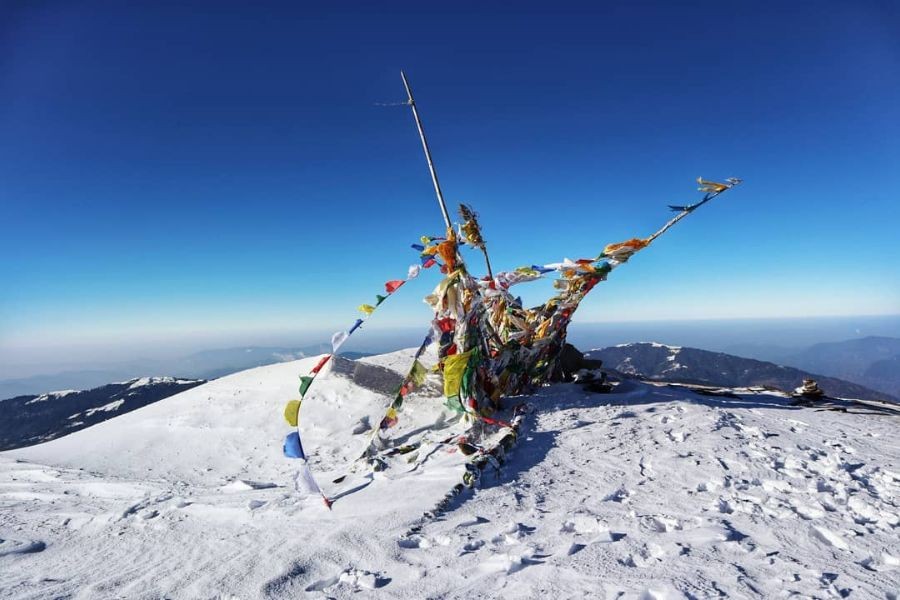
Pikey Peak Trek in Winter stands out as one of the best winter trekking options in the entire Everest region—especially for those seeking adventure without extreme altitude challenges or busy trails. At a maximum elevation of 4,065 meters, the trek remains comfortably below the high-altitude threshold that often requires acclimatization. This makes it accessible to both beginners and experienced trekkers, even during the colder months.
Unlike popular routes such as the Everest Base Camp trek, Pikey Peak remains peaceful and uncrowded in winter. You can enjoy the Himalayan landscapes in complete serenity, without the rush of large trekking groups. The snow-dusted forests, open meadows, and hidden villages offer a raw, untouched charm that’s hard to find elsewhere during peak season.
Another reason this trek is so winter-friendly is its safety. The well-defined paths, moderate duration, and support from reliable local guides, like those from Himalayan Ecological Trekking, make it a secure choice even when the region is blanketed in snow. With stunning Everest views, authentic cultural experiences, and easy accessibility from Kathmandu, Pikey Peak offers the perfect balance of adventure and comfort, making it one of the finest offbeat winter treks in Nepal.
Winter Challenges & Safety Tips
While the Pikey Peak Trek in Winter is scenic and peaceful, it also comes with unique challenges that require preparation and awareness. Snow-covered trails, freezing temperatures, and shorter daylight hours can make the trek more demanding if you're not properly equipped. However, with the right guidance and gear, these challenges can be easily managed, making the experience both safe and enjoyable.
Snow on the trail may slow your pace, especially in January when the snowfall is heaviest. Trekking poles, sturdy waterproof boots, and microspikes are highly recommended for balance and grip. Layered clothing is essential to regulate body temperature and stay warm during early morning hikes and cold evenings. Don’t forget gloves, a thermal hat, and sunglasses to protect against wind and snow glare.
Managing the cold is more about staying dry and moving steadily rather than rushing. Nights can be extremely chilly—sometimes below –10°C—so high-quality sleeping bags and insulated jackets are a must.
Trekking with a certified guide from Himalayan Ecological Trekking ensures that you remain on the safest paths, stay informed about trail conditions, and have support if the weather changes suddenly. With the right mindset and preparation, winter adds excitement without compromising safety.
Packing Essentials: Gear for Winter Trekking (Dec-Feb)
Packing smart is key to enjoying the Pikey Peak Trek in Winter comfortably and safely. From December to February, temperatures can drop well below freezing, especially at night. The right gear will protect you from the cold, snow, and changing mountain weather. Preparation doesn’t have to be complicated—you just need to focus on warmth, layering, and traction.
Layered Clothing System:
Moisture-wicking base layer
Insulating middle layer (fleece or down jacket)
Waterproof and windproof outer shell
Essential Winter Wear:
High-quality thermal jacket
Insulated trekking pants
Thermal innerwear (top and bottom)
Woolen socks (multiple pairs)
Warm hat/beanie
Waterproof gloves
Neck gaiter or buff
Footwear & Traction:
Waterproof hiking boots with a strong grip
Microspikes or lightweight crampons for icy sections
Trekking poles for added stability
Cold-Weather Camping & Safety:
Four-season sleeping bag (comfort rated for –10°C or lower)
Headlamp with extra batteries
Sunglasses with UV protection (snow glare can be intense)
When you trek with Himalayan Ecological Trekking, they can also assist you in renting or purchasing essential gear in Kathmandu. Smart packing essentials for Pikey Peak Trek ensures a warmer, safer, and far more enjoyable winter adventure.
FAQs: Pikey Peak Trek in Winter
What is the best month to trek Pikey Peak in winter?
December and February are ideal months for trekking Pikey Peak in winter. December offers fresh early snow and clear skies, while February brings slightly warmer days and early rhododendron blooms.
How physically demanding is the Pikey Peak trek in winter?
The trek is moderately challenging, suitable for beginners with good fitness as well as experienced trekkers. The altitude is manageable, with the highest point at 4,065 meters.
Is the trail accessible by road during winter?
Yes, the trailhead is reachable by jeep or bus from Kathmandu, although roads may be rough due to winter weather. Your trekking agency will arrange safe transport.
Do I need prior trekking experience to do this winter trek?
No, prior trekking experience is not mandatory. However, basic fitness and preparation for cold-weather hiking are recommended.
How cold does it get on the trek?
Temperatures can drop below –10°C at night, especially in January. Daytime temperatures are milder but still cold, so proper winter gear is essential.
Are there good accommodation and food options along the route?
Yes, you will find comfortable teahouses and lodges offering warm meals and hot showers in most villages, even in winter.
Is it safe to trek Pikey Peak in winter without a guide?
While possible, trekking with an experienced guide, like those from Himalayan Ecological Trekking, is highly recommended for safety, navigation, and local insights.
Conclusion: Your Perfect Himalayan Winter Adventure
The Pikey peak trek in Winter is a unique Himalayan adventure and one of the Best winter treks in Everest region. That perfectly blends breathtaking mountain vistas, peaceful snowy trails, and authentic Sherpa culture. Whether you’re drawn by the stunning sunrise views of Mt. Everest, the quiet solitude of offbeat routes, or the warmth of winter hospitality in remote villages, this trek offers an experience unlike any other in the Everest region.
With its manageable altitude, clear winter skies, and the expert support from Himalayan Ecological Trekking, Pikey Peak becomes a safe and rewarding choice for both novice and seasoned trekkers. The winter season adds a magical layer of serenity and pristine beauty, inviting you to connect deeply with nature and culture in one of the world’s most spectacular mountain landscapes.
If you’re ready to embrace the challenge and charm of winter trekking, Pikey Peak awaits with open arms — a gateway to Himalayan wonders that will stay with you long after the snow has melted. Start planning your winter journey today and discover the unforgettable magic of Pikey Peak.
Ready to experience the magic of the Pikey Peak Trek in Winter?
Get expert guidance and personalized support from Himalayan Ecological Trekking to make your journey safe and unforgettable.
Contact us today to book your trek or get more information:
WhatsApp: +977 9851006023 (Bikesh)
Email: [email protected]
Start your Himalayan adventure now—your winter trekking dream awaits!



